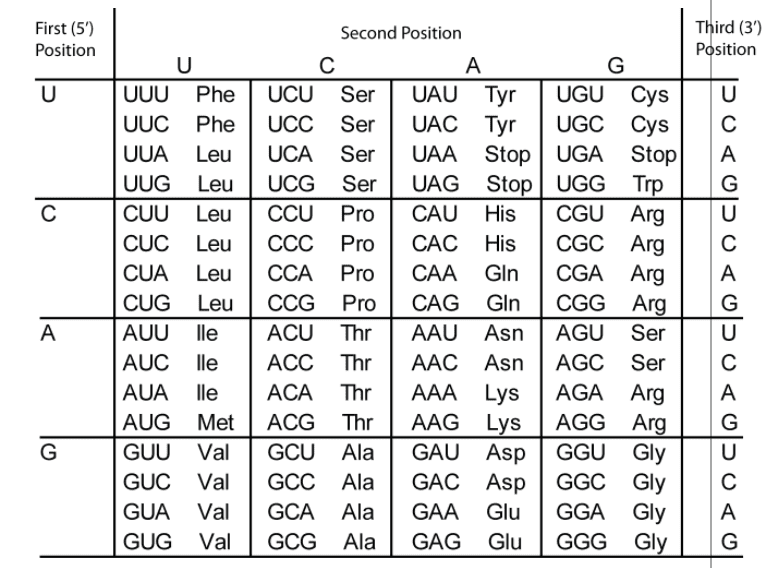HONR 1034 Chapter Notes - Chapter 13: Genetic Code, Start Codon, Ribonucleotide

Transcription and the Genetic Code
I. Genetic code → almost universal for all organisms
A. 4 nucleotides - 20 amino acids
1. How is the nucleotide information translated into proteins?
B. 43 = 64 possible code words - triplets of nucleotides - smallest units of uniform length that can
code for all amino acids
1. Have 1 start codon, and three stop codons where translation stops
2. All the others are coding for different amino acids
C. Genetic code is written in linear form, using as “letters” the ribonucleotide bases
D. Each “word” within the mRNA consists of three ribonucleotide letters – triplet code - codon
E. The code is unambiguous – one codon specifies a single amino acid ALWAYS
F. The code is degenerate – amino acid can be specified by more than one codon
G. The code contains one ”start” and three “stop” codons
H. The code is said to be commaless – no internal punctuation – codons read one after another
I. The code is nonoverlapping – any single ribonucleotide is part of any codon
J. The sequence of codons in a gene is collinear
K. The code is nearly universal – minor exceptions
II. Basic operational patterns of the code
A. mRNA: even though genetic information is stored in DNA, the code that is translated to proteins
is in the RNA; mRNA is an informational RNA because it carries the information
B. rRNA is a functional RNA
C. tRNA is also functional also involved in protein synthesis - transfers specific amino acids based
on these sequences; each amino acid is carried by a specific tRNA
III. RNA - intermediate molecule in the process of information flow between DNA and the protein (came
from experiments using bacteriophages)
A. DNA mostly associated with chromosomes in the nucleus, and protein synthesis occurs in
association with ribosomes that are in the cytoplasm
1. DNA doesn’t participate directly in protein synthesis
B. RNA is synthesized in the nucleus and chemically similar to DNA
C. RNA migrates to cytoplasm where it will bind to ribosomes and be translated to proteins
D. Amount of RNA is generally proportional to the amount of the protein in a cell
E. mRNA is short lived - don’t produce proteins when they don’t need them because they use
energy → when its not needed anymore it will be degraded
IV. RNA polymerase directs RNA synthesis
A. RNA polymerase: the enzyme that helps to synthesize RNA from DNA
V. Transcription: the process by which RNA molecules are synthesized on a DNA template; genetic
information goes from DNA to become RNA
A. Transcription is the initiation step in the process of information flow
VI. The process of transcription
A. Template binding: the initial step in prokaryotic gene transcription → interaction with the
DNA and protein
1. Starts when RNA polymerase sigma subunit recognizes a specific DNA sequence the
promoter region (located in the 5’ region)
a) RNA polymerase functions like DNA polymerase → it binds, moves along,
but does not require a primer
b) Binding results in the denaturation of the helix to unwind so a single strand is
formed
c) In bacteria and eukaryotic organisms we know what the sequences are to
identify them
2. Interaction of promoters with RNA polymerase is what governs the efficiency of the
initiation of transcription
find more resources at oneclass.com
find more resources at oneclass.com



